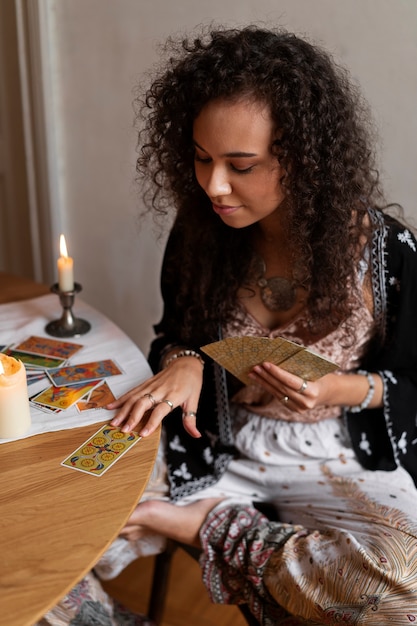
Welcome to your go-to guide for tarot reading! Whether you’re new to the mystical world of tarot or looking to deepen your knowledge, this guide covers everything. Dive into the history, learn about different decks, discover how to choose the right tarot spreads, and get tips for accurate card interpretation for yourself and others.
Let’s start by exploring the fascinating origins of tarot cards, which began as a four-suited card game in Europe during the early 14th century. Initially popular in Italy, notable decks like the “Visconti-Sforza” and “Mantegna” emerged. Mystical associations with tarot began in the 16th century, with figures like British astronomer John Dee using the cards for spiritual conversations.
French occultist Antoine Court de Gébelin proposed in the 18th century that tarot cards carried ancient Egyptian wisdom. During the 19th century, researchers such as Eliphas Levi linked tarot to the Hebrew Enochian alphabet. By the late 19th century, tarot evolved from a fortune-telling tool into a method for spiritual insights through card symbolism.
A standard tarot deck has 78 cards divided into the Major Arcana and Minor Arcana. The Major Arcana, with 22 numbered cards, represents significant life experiences. The Minor Arcana consists of 56 cards divided into four suits: wands, cups, swords, and pentacles, each symbolizing different aspects of life. Each card can be interpreted upright or reversed, offering varied meanings.
Understanding the cards is essential. For instance, The Fool card signifies openness to new experiences, while The Magician points to utilizing unique talents. The High Priestess advises trusting intuition. The Emperor stands for authority, and The Lovers suggest a focus on relationships. Each card carries specific guidance depending on the question asked.
The Rider-Waite deck, created in 1909, is a favorite among readers for its rich symbolism. The Thoth Tarot and Wild Unknown Tarot are notable for their unique artistic styles and deep symbolic representations. Other popular decks include Shadowscapes Tarot, Gendron Tarot, Black and White Tarot, and Tarot of Dreams.
Different types of tarot readings serve various purposes. General readings provide an overview of life patterns, while question-based readings offer clarity on specific issues. Theme-based readings explore particular life aspects like personal growth or relationships. Past or future readings shed light on events influencing the present or show future possibilities. Yes-or-no readings give quick answers, and one-card readings offer concise guidance.
Preparing for a tarot reading involves connecting with your deck, understanding card meanings, and setting a focused intention. Create a serene reading space, choose an appropriate spread, and interpret the cards by combining intuition with traditional meanings. Reflect on the insights gained to integrate them into your life.
When reading for others, maintain clear boundaries and create a comforting environment. Explain the process, listen attentively, and provide compassionate interpretations. Honesty is vital while ensuring the querent feels respected and understood.
Different tarot spreads reveal various insights. The Three-Card spread can address past, present, and future or explore challenges and opportunities. The Celtic Cross provides a detailed analysis, incorporating influences and potential outcomes. The Horseshoe spread offers a strategic view of situations, and Decision Spreads help evaluate different choices.
Thinking about getting an online tarot reading? Services like Trusted Psychics offer access to experienced readers who provide insightful guidance. These online platforms allow convenient and affordable access to skilled tarot readers, making it easy to find answers to your questions from the comfort of your home.
Remember, tarot reading is a blend of knowledge, intuition, and practice. Whether you’re seeking daily guidance or deep spiritual understanding, connecting with your deck and honing your skills will enrich your tarot journey.


